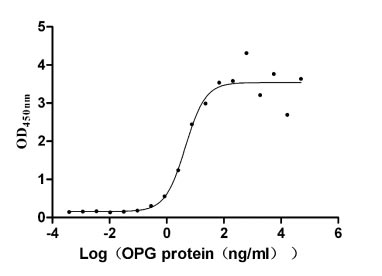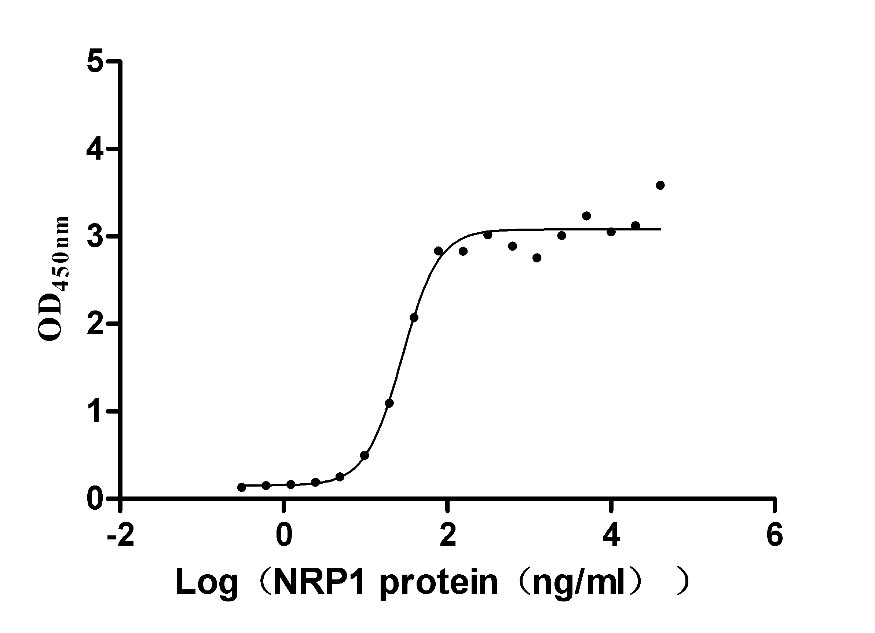Recombinant Human GTP-binding protein Rit1 (RIT1)
-
中文名称:人RIT1重组蛋白
-
货号:CSB-YP846116HU
-
规格:
-
来源:Yeast
-
其他:
-
中文名称:人RIT1重组蛋白
-
货号:CSB-EP846116HU
-
规格:
-
来源:E.coli
-
其他:
-
中文名称:人RIT1重组蛋白
-
货号:CSB-EP846116HU-B
-
规格:
-
来源:E.coli
-
共轭:Avi-tag Biotinylated
E. coli biotin ligase (BirA) is highly specific in covalently attaching biotin to the 15 amino acid AviTag peptide. This recombinant protein was biotinylated in vivo by AviTag-BirA technology, which method is BriA catalyzes amide linkage between the biotin and the specific lysine of the AviTag.
-
其他:
-
中文名称:人RIT1重组蛋白
-
货号:CSB-BP846116HU
-
规格:
-
来源:Baculovirus
-
其他:
-
中文名称:人RIT1重组蛋白
-
货号:CSB-MP846116HU
-
规格:
-
来源:Mammalian cell
-
其他:
产品详情
-
纯度:>85% (SDS-PAGE)
-
基因名:
-
Uniprot No.:
-
别名:GTP binding protein Roc1; GTP-binding protein Rit1; NS8; Ras like protein expressed in many tissues; Ras like without CAAX 1; Ras-like protein expressed in many tissues; Ras-like without CAAX protein 1; RIBB; Ric like expressed in many tissues; Ric-like protein without CAAX motif 1; RIT; RIT1; RIT1_HUMAN; ROC1
-
种属:Homo sapiens (Human)
-
蛋白长度:full length protein
-
表达区域:1-219
-
氨基酸序列MDSGTRPVGS CCSSPAGLSR EYKLVMLGAG GVGKSAMTMQ FISHRFPEDH DPTIEDAYKI RIRIDDEPAN LDILDTAGQA EFTAMRDQYM RAGEGFIICY SITDRRSFHE VREFKQLIYR VRRTDDTPVV LVGNKSDLKQ LRQVTKEEGL ALAREFSCPF FETSAAYRYY IDDVFHALVR EIRRKEKEAV LAMEKKSKPK NSVWKRLKSP FRKKKDSVT
-
蛋白标签:Tag type will be determined during the manufacturing process.
The tag type will be determined during production process. If you have specified tag type, please tell us and we will develop the specified tag preferentially. -
产品提供形式:Lyophilized powder
Note: We will preferentially ship the format that we have in stock, however, if you have any special requirement for the format, please remark your requirement when placing the order, we will prepare according to your demand. -
复溶:We recommend that this vial be briefly centrifuged prior to opening to bring the contents to the bottom. Please reconstitute protein in deionized sterile water to a concentration of 0.1-1.0 mg/mL.We recommend to add 5-50% of glycerol (final concentration) and aliquot for long-term storage at -20℃/-80℃. Our default final concentration of glycerol is 50%. Customers could use it as reference.
-
储存条件:Store at -20°C/-80°C upon receipt, aliquoting is necessary for mutiple use. Avoid repeated freeze-thaw cycles.
-
保质期:The shelf life is related to many factors, storage state, buffer ingredients, storage temperature and the stability of the protein itself.
Generally, the shelf life of liquid form is 6 months at -20°C/-80°C. The shelf life of lyophilized form is 12 months at -20°C/-80°C. -
货期:Delivery time may differ from different purchasing way or location, please kindly consult your local distributors for specific delivery time.Note: All of our proteins are default shipped with normal blue ice packs, if you request to ship with dry ice, please communicate with us in advance and extra fees will be charged.
-
注意事项:Repeated freezing and thawing is not recommended. Store working aliquots at 4°C for up to one week.
-
Datasheet :Please contact us to get it.
相关产品
靶点详情
-
功能:Plays a crucial role in coupling NGF stimulation to the activation of both EPHB2 and MAPK14 signaling pathways and in NGF-dependent neuronal differentiation. Involved in ELK1 transactivation through the Ras-MAPK signaling cascade that mediates a wide variety of cellular functions, including cell proliferation, survival, and differentiation.
-
基因功能参考文献:
- The functional assessment supported the pathogenicity of the RAF1 and RIT1 variants of unknown significance (VUSs), while the significance of two VUSs in A2ML1 remained unclear. PMID: 29402968
- Our report contributes to the delineation of the phenotype associated with RIT1 mutations and underlines that lymphatic involvement is part of this spectrum PMID: 27109146
- RIT1 is one of the major genes for NS. The RIT1-associated phenotype differs gradually from other NS subtypes, with a high prevalence of cardiovascular manifestations, especially hypertrophic cardiomyopathy. PMID: 27101134
- Congenital left main coronary artery atresia in a Noonan syndrome is associated with RIT1 variant, leading to unrescued sudden death. PMID: 28347726
- Noonan patients with germline RIT1 mutations are not at high risk to developing JMML or ALL, and that RIT1 has at most a marginal role in these sporadic malignancies. PMID: 26757980
- Biochemical Classification of Disease-associated Mutants of RAS-like Protein Expressed in Many Tissues (RIT1). PMID: 27226556
- We report on a 2.5-year-old male patient with clinical signs of NS and hematologic abnormalities, in whom a novel heterozygous substitution in RIT1 with probable pathogenicity was detected. PMID: 26518681
- Mutations in RIT1 cause Noonan syndrome. Mutations in RIT1 affect RAS-MAPK/MEK-ERK signaling. The mutant RIT1 protein may possess reduced GTPase activity or a diminished ability to interact with cellular GTPase activating proteins. PMID: 25959749
- elevated expression of RIT1 may contribute to the progression of endometrial cancer and thus may serve as a novel prognostic marker and a promising molecular target for the treatment of endometrial cancer. PMID: 26617739
- Because of the relatively high frequency of mutations in RIT1 among patients with NS and its occurrence in different populations, we suggest that it should be added to the list of genes included in panels for the molecular diagnosis of NS. PMID: 25124994
- A genotype-phenotype correlation analysis of available records indicated that germline RIT1 mutations cause a noonan syndrome phenotype characterized by a mild facial appearance. PMID: 26714497
- four additional cases of Noonan syndrome with mutations in RIT1, were identified. PMID: 24939608
- Data identify RIT1 as a driver oncogene in a specific subset of lung adenocarcinomas. PMID: 24469055
- we highlight recent studies using transgenic and knockout animal models which have begun to elucidate the physiological roles for the Rit subfamily, including emerging roles in the regulation of neuronal morphology and cellular survival signaling PMID: 23770287
- ROC1 knockdown remarkably inhibited bladder cancer cell growth, arrested cells at the G2 phase of the cell cycle, and induced the p53-dependent cell senescence. PMID: 23667514
- study demonstrates that RIT1 abnormalities, including activating mutations and locus amplifications, are novel lesions in a subgroup of patients with myeloid neoplasms, particularly frequent in chronic myelomonocytic leukemia PMID: 23765226
- Five RIT1 alterations identified in children with Noonan syndrome enhanced ELK1 transactivation. PMID: 23791108
- the present studies identify a critical role for the Rit-p38 MAPK signaling cascade in promoting hippocampal neuron survival following oxidative stress PMID: 23123784
- the Rit-p38-MSK1/2 signaling pathway may have an important role in the stress-dependent regulation of CREB-dependent gene expression. PMID: 23038261
- the studies establish Rit as a central regulator of a p38 MAPK-dependent signaling cascade that functions as a critical cellular survival mechanism in response to stress PMID: 21444726
- Rit plays a key role in human neuronal development and regeneration through activating both known and as yet undefined signaling pathways PMID: 12668729
- Gene amplification is one of the main activating ways of RIT1 gene in hepatocellular carcinoma (HCC), and its amplification might be correlated with HCC carcinogenesis, while point mutation might be not. PMID: 14767908
显示更多
收起更多
-
相关疾病:Noonan syndrome 8 (NS8)
-
亚细胞定位:Cell membrane.
-
蛋白家族:Small GTPase superfamily, Ras family
-
组织特异性:Expressed in many tissues.
-
数据库链接:
HGNC: 10023
OMIM: 609591
KEGG: hsa:6016
STRING: 9606.ENSP00000357306
UniGene: Hs.491234
Most popular with customers
-
Recombinant Human Tumor necrosis factor receptor superfamily member 11B (TNFRSF11B) (Active)
Express system: Mammalian cell
Species: Homo sapiens (Human)
-
Recombinant Human Neuropilin-1 (NRP1) (Active)
Express system: Mammalian cell
Species: Homo sapiens (Human)
-
Recombinant Human C-C chemokine receptor type 8 (CCR8)-VLPs (Active)
Express system: Mammalian cell
Species: Homo sapiens (Human)
-
Recombinant Human CD81 antigen (CD81), partial (Active)
Express system: Mammalian cell
Species: Homo sapiens (Human)
















